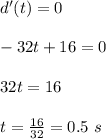
Mathematics, 17.01.2020 02:31 kalebstone8357
Ritvik tosses a ball from where he stands on a balcony to his friend on the ground. the
height, in feet, of the ball can be represented by the function d(t) = -16° + 16+ 9,
where represents time in seconds.
part a: from what height was the ball tossed?
part b: what is the maximum height of the ball?
part c: how long does it take the ball to reach its maximum height?

Answers: 3


Other questions on the subject: Mathematics

Mathematics, 21.06.2019 20:00, tansebas1107
Can you me find the missing length. i attached an image.
Answers: 1

Mathematics, 21.06.2019 22:30, coolcat3190
What is 1.5% of 120 or what number is 1.5% of 120
Answers: 2

Mathematics, 21.06.2019 22:30, thelonewolf5020
Amachine that produces a special type of transistor (a component of computers) has a 2% defective rate. the production is considered a random process where each transistor is independent of the others. (a) what is the probability that the 10th transistor produced is the first with a defect? (b) what is the probability that the machine produces no defective transistors in a batch of 100? (c) on average, how many transistors would you expect to be produced before the first with a defect? what is the standard deviation? (d) another machine that also produces transistors has a 5% defective rate where each transistor is produced independent of the others. on average how many transistors would you expect to be produced with this machine before the first with a defect? what is the standard deviation? (e) based on your answers to parts (c) and (d), how does increasing the probability of an event a↵ect the mean and standard deviation of the wait time until success?
Answers: 3

Mathematics, 21.06.2019 23:00, janeou17xn
The equation shown below represents function f. f(x)= -2x+5 the graph shown below represents function g. which of the following statements is true? a. over the interval [2, 4], the average rate of change of f is the same as the average rate of change of g. the y-intercept of function f is less than the y-intercept of function g. b. over the interval [2, 4], the average rate of change of f is greater than the average rate of change of g. the y-intercept of function f is greater than the y-intercept of function g. c. over the interval [2, 4], the average rate of change of f is the same as the average rate of change of g. the y-intercept of function f is greater than the y-intercept of function g. d. over the interval [2, 4], the average rate of change of f is less than the average rate of change of g. the y-intercept of function f is the same as the y-intercept of function g.
Answers: 1
You know the right answer?
Ritvik tosses a ball from where he stands on a balcony to his friend on the ground. the
height...
height...
Questions in other subjects:

Physics, 24.09.2020 08:01

Geography, 24.09.2020 08:01


Mathematics, 24.09.2020 08:01

Computers and Technology, 24.09.2020 08:01



Biology, 24.09.2020 08:01

Geography, 24.09.2020 08:01










